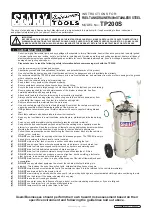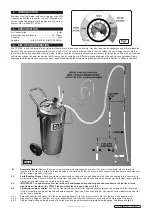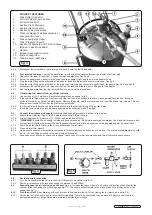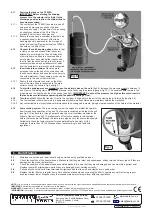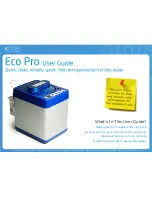
Original Language Version
TP200S Issue No:1 - 06/09/10
5.1
Maintenance, service and repair should only be carried out by qualified persons.
5.2
Check the condition of the transfer hoses. Make sure that they are intact and undamaged, without cracks, holes or leaks. If they are
damaged or they leak, replace them.
5.3
Check the condition of the adaptors and associated washers. Be sure that they are undamaged and can maintain a perfect seal.
Replace them with original spare parts if they are damaged or not working correctly.
5.4
Periodically check the earth strap terminals for tightness and that the wire and clamps are in good order.
5.5
Replace the fuel filter on a regular basis. Care should be taken when unscrewing the filter to capture any spilt fuel using rags or
absorbent paper towel. Dispose of any fuel soaked material according to local authority regulations.
5. MAINTENANCE
4.11
Draining the tank on the TP200S.
IMPORTANT. Before starting the draining
process turn the selector valve (fig.6) to the
discharge position to allow the drainer tank to
become pressurised.
4.11.1
The contents of the TP200S tank are drained off
using the air pressure supplied by the local
incoming air supply. The pressure of the incoming
air supply can remain at the 72 to 100psi
previously set for the suction process.
4.11.2 Ensure that you have a container ready that has
a capacity equal to the amount of fuel to be
discharged and is approved for the storage of
petrol or diesel fuel. Remember that the TP200S
can hold up to 40ltrs of fuel.
4.12
Connect the earth bonding straps.
Ensure that
a clamp on one end of each strap is securely
attached to a metal part on the unit. Attach the
other clip from one strap to a known earthing
point, away from any potential fuel vapour, and
the clip from the second strap to the container. If
necessary scrape away a small amount of paint
from the container to improve the earth connection.
4.13
Insert tube into container.
Place the metal
extension tube on the end of the main hose into
the chosen container and open the valve (lever in
line with metal tube). If necessary a probe can be
connected to the end of the metal tube.
4.13.1 Ensure that the female connector on the other
end of the main hose is connected to the male
outlet connector as shown in fig.6 and fig.3-1.
4.14
To start the draining process gradually open the air inlet valve on the unit.
(fig.3-2) Increase the pressure slowly to between 15
and 21psi until draining starts. Monitor the pressure in the tank using the pressure gauge (fig.3-7). The needle should remain in the
green area on the right hand side of the gauge (see fig.1).
IMPORTANT. Do not set the pressure too high as this could result in
the tank pressure relief valve operating and the possible venting of fuel.
4.15
Turn the unit off.
When the transfer of fuel to the container is finished turn the unit off by closing the air inlet valve (see fig.3-2).
4.15.1 The fuel container should be stored in a designated lockable, well-ventilated area, preferably outside the workshop.
4.15.2 Any contaminated fuel or petrol/diesel mixtures should be consigned to waste, giving a clear description of the nature of the material.
fig.6
4.16
Fume venting system.
The fume venting system is designed to protect the operator
from fumes during operation of the unit. The fumes are collected at the top of the unit
(see fig.3-13) and are fed through a plastic pipe to a small container mounted at the
bottom of the unit (see fig.7). Small amounts of fuel will condense in this container
before the fumes are fed through the fume return pipe back to the source tank/vehicle.
Periodically check the fume container for accumulated fuel and empty it if the
container is more than 1/3 full. Dispose of any fuel according to local authority
regulations.
fig.7
NOTE:
It is our policy to continually improve products and as such we reserve the right to alter data, specifications and component parts without prior notice.
IMPORTANT:
No liability is accepted for incorrect use of this product.
WARRANTY:
Guarantee is 12 months from purchase date, proof of which will be required for any claim.
INFORMATION:
For a copy of our latest catalogue and promotions call us on 01284 757525 and leave your full name and address, including postcode.
01284 757500
01284 703534
sales@sealey.co.uk
Sole UK Distributor, Sealey Group,
Kempson Way, Suffolk Business Park
,
Bury St. Edmunds, Suffolk,
IP32 7AR
www.sealey.co.uk
Web

